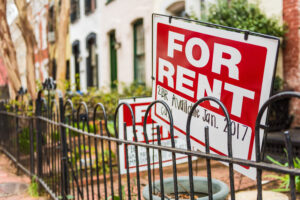It has been a year since the world came to a bitter halt. While we knew about COVID-19 throughout January and February of 2020, it was name-dropped in jest. It was a silly cold that was overseas, sounded a bit rough sure, but it wasn’t a big bother. Not until March did the gravity of the situation hit.
March 2020 started with the official shutdown. No more restaurants, malls, or free-wheeling trips to the pharmacy whenever you felt like it. Gas prices dropped and stores shuttered their doors as everyone was forced to stay home. It’s taken a full year, but we have started to climb our way back up from the ditch to our somewhat normal “new” normal. So, what exactly happened?
Evictions
Because of the shut-down, many people lost their jobs and just as many people were suddenly and through no fault of their own were left unable to pay their rent. At first, the eviction moratoriums were for two months, after which it was expected people were looking forward to getting rid of unpaying tenants. We released our first warning in July of 2020, in which we spoke of the oncoming “Eviction Tsunami.” After all, it was just one little moratorium, right, and the evictions would hit right after.
It has been a year since the world came to a bitter halt. While we knew about COVID-19 throughout January and February of 2020, it was name-dropped in jest. It was a silly cold that was overseas, sounded a bit rough sure, but it wasn’t a big bother. Not until March did the gravity of the situation hit.
March 2020 started with the official shutdown. No more restaurants, malls, or free-wheeling trips to the pharmacy whenever you felt like it. Gas prices dropped and stores shuttered their doors as everyone was forced to stay home. It’s taken a full year, but we have started to climb our way back up from the ditch to our somewhat normal “new” normal. So, what exactly happened?
Evictions
Because of the shut-down, many people lost their jobs and just as many people were suddenly and through no fault of their own were left unable to pay their rent. At first, the eviction moratoriums were for two months, after which it was expected people were looking forward to getting rid of unpaying tenants. We released our first warning in July of 2020, in which we spoke of the oncoming “Eviction Tsunami.” After all, it was just one little moratorium, right, and the evictions would hit right after.
That has been delayed over and over again, with the latest news that it will be extended again until June, 2021. Because of this, the mass evictions many have been expecting just hasn’t happened yet. Evictions are still on hold and may be for a while. That doesn’t mean that the ‘tsunami’ won’t happen – most likely it will, and it could be assumed that even more evictions will occur than what may have happened way back in July, 2020. While we can’t predict the future, we can assume more people have been out of work for longer and have used up their rainy-day funds. The latest COVID-19 relief aid has aimed to target the rental debts that have accrued and hopefully that will temper the dam of evictions.

That has been delayed over and over again, with the latest news that it will be extended again until June, 2021. Because of this, the mass evictions many have been expecting just hasn’t happened yet. Evictions are still on hold and may be for a while. That doesn’t mean that the ‘tsunami’ won’t happen – most likely it will, and it could be assumed that even more evictions will occur than what may have happened way back in July, 2020. While we can’t predict the future, we can assume more people have been out of work for longer and have used up their rainy-day funds. The latest COVID-19 relief aid has aimed to target the rental debts that have accrued and hopefully that will temper the dam of evictions.

Tenant Screening Data Restrictions
With 2020 being the – ahem – stellar year that it was, legislation had to pull a few tricks to keep up. If you’re trying to relax, you can count on the Regulatory Matrix to keep track for you. In the meantime, here’s a run-down of some of the changes to the legislative landscape.
Tenant Screening Data Restrictions
With 2020 being the – ahem – stellar year that it was, legislation had to pull a few tricks to keep up. If you’re trying to relax, you can count on the Regulatory Matrix to keep track for you. In the meantime, here’s a run-down of some of the changes to the legislative landscape.

No Debt: During your tenant screening in California, you cannot look at any debt accrued because of the COVID-19 pandemic. That means any debt gained because of mismanagement is on the table, but if they lost their job because of the pandemic, it must be ignored.
No Evictions: For example, in New York, if one has proof of hardship related to the pandemic, evictions and foreclosures for renters and or owners could be stopped until May. In D.C., evictions are sealed. With B23-0941/B23-0940, Washington D.C. is sealing off more records. Should eviction judgements rule in the tenant’s favor, the record will be sealed thanks to the pandemic.
No Debt: During your tenant screening in California, you cannot look at any debt accrued because of the COVID-19 pandemic. That means any debt gained because of mismanagement is on the table, but if they lost their job because of the pandemic, it must be ignored.
No Evictions: For example, in New York, if one has proof of hardship related to the pandemic, evictions and foreclosures for renters and or owners could be stopped until May. In D.C., evictions are sealed. With B23-0941/B23-0940, Washington D.C. is sealing off more records. Should eviction judgements rule in the tenant’s favor, the record will be sealed thanks to the pandemic.

Credit Scores
There is a bright side. Even through COVID-19, many people’s credit scores weren’t too adversely affected. Despite the economic downturn, in summer 94% of tenants were able to pay some if not all of their rent. The “Excellent” and “Good” scores even increased by well over 5%, which is good news. Now that the country is bouncing back, we can expect this to at least stabilize. Consumer debt has increased over the pandemic, but those with the lowest scores actually had their debt decrease, which is only good news.
With the restrictions lifting and vaccines rolling out to larger and larger groups, more people will find their lives on steadier ground. This means more people going back to work, the restaurants that weren’t permanently shuddered will open, and those who can start paying their rent should. 2020 was rough as a year, but at least 2021 seems to be looking upwards so far. The latest Rescue Plan and stimulus package should take us far enough to reach past COVID-19.
Credit Scores
There is a bright side. Even through COVID-19, many people’s credit scores weren’t too adversely affected. Despite the economic downturn, in summer 94% of tenants were able to pay some if not all of their rent. The “Excellent” and “Good” scores even increased by well over 5%, which is good news. Now that the country is bouncing back, we can expect this to at least stabilize. Consumer debt has increased over the pandemic, but those with the lowest scores actually had their debt decrease, which is only good news.
With the restrictions lifting and vaccines rolling out to larger and larger groups, more people will find their lives on steadier ground. This means more people going back to work, the restaurants that weren’t permanently shuddered will open, and those who can start paying their rent should. 2020 was rough as a year, but at least 2021 seems to be looking upwards so far. The latest Rescue Plan and stimulus package should take us far enough to reach past COVID-19.







